
|   |

|   |
The 29th OMC Guru Kelucharan Mohapatra Award Festival - Tapati Chowdhurie e-mail: tapatichow@yahoo.co.in Photos courtesy: Srjan September 18, 2023 The 29th edition of the OMC Guru Kelucharan Mohapatra (GKCM) Award Festival was organised by Srjan-Guru Kelucharan Mohapatra Odissi Nrityabasa in collaboration with Sri Sri University, Cuttack, from September 5 to 9, 2023 at Rabindra Mandap, Bhubaneswar. The festival featured a galaxy of dancers and musicians who are all famed artistes in their own right. 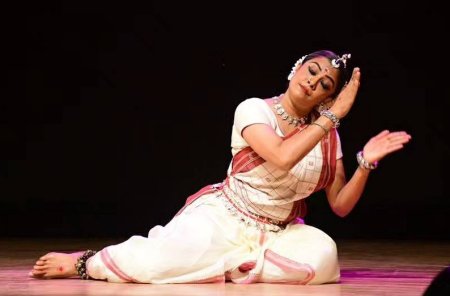 Shashwati Garai Ghosh The first day of the festival was inaugurated by Odissi dancer Shashwati Garai Ghosh who performed Mahamaya and Yashoda's version of the story of Ramayana to her son, little Krishna. Yashoda's Ramayana is a self-created version of the Ramayana as usually told by mothers to their young sons, with twists and turns as it suits the story-telling moment. But if the son is an incarnation of Vishnu then the reaction of the god child to the story will of course be different from the reaction of a human child. Yashoda's dilemma is that her child is no ordinary child. This piece of abhinaya imbibed from Kalanidhi Narayanan has been re-choreographed by her dance guru Sharmila Biswas. When mother Yashoda is at her wits' end she decides to re-tell the story of the fierce Ravana and the abduction of Sita at which point child Krishna wishes to strike the demon down with his bow and arrow and becomes wide awake. The first piece Mahamaya was about Devi - who is infinite, birthless beyond time and space. Devi visits during Devipaksha during autumn and as Mahamaya, the timeless mother omnipresent everywhere; a symbol of Shakti in its subtlest form; the annihilator of Mahishasura, Bana, Shumbha and Nishumbha, Madhu-Kaitabha, an epitome of protective quality, love, prosperity, knowledge, compassion as well as energy, was essayed. While dancers have the freedom to extend the boundaries of their learnt genre, the original and learnt style of Odissi was missing in the presentation. Shailaputri, the daughter of the mountains, is powerful and grounded, an epitome of strength, courage, composure, determination, devotion, benevolence, fearlessness and joy. The piece involved the rendition of many of the nine rasas that is acquired through rigorous training. The mighty Asuras, all armed with boons, fought with fury, but the strength of the all-powerful Goddess did not come through. After all she was redeeming the world of Asuras to bring benevolence to the world and the fight was not between two equals. The performer's physical movements had marvellous vibrancy and energy, result of years of practice and more practice. She covered the stage with expertise and skill. It found appreciation with the audience. 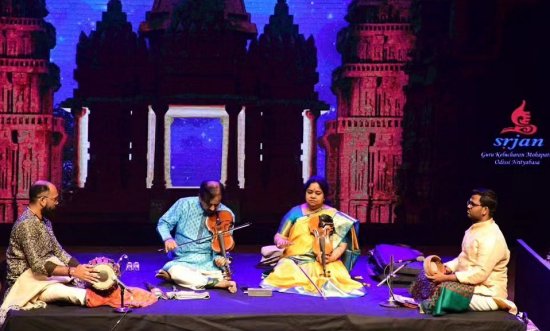 Lalgudi GJR Krishnan and Lalgudi Vijayalakshmi The brother-sister violinist duo of Lalgudi GJR Krishnan and Lalgudi Vijayalakshmi - disciples of Lalgudi Jayaraman - regaled the audience with a composition of St Thyagaraja in ragam Kaanada and rupaka talam. The second piece on Devi was a composition of Muthuswami Dikshitar in ragam Kalyani and adi talam. The song "Meenakshi me mudam dehi" penned by Dikshitar was sung to Rabindranath Tagore by Savitri, a Carnatic music student. The poet had composed his lyrics "Basanti hey bhubono Mohini" based on Dikshitar's bhajan. In the later part of playing this song on their violin, they rendered kalpana swara or improvisation much to the delight of the audience. To pay their homage to Guru Kelucharan Mohapatra they played his favourite number "Kuru yadu nandana" from the Geeta Govinda and ended their recital with a Tillana composed by their father/guru Lalgudi Jayaraman. It was a grand ending of the first day of the festival when rasikas of dance and music made their way out humming in their minds, strains of "Kuru yadu nandana". 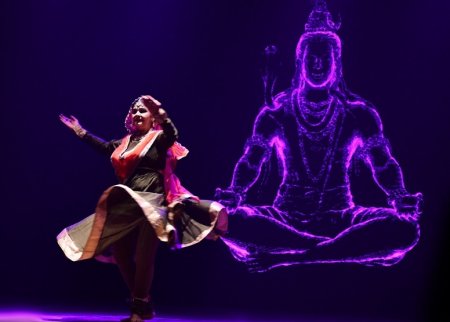 Shila Mehta Kathak dancer Shila Mehta danced on the second day of the festival. A Lucknow gharana Kathaka, she has learnt under stalwarts like Pt Vijay Shankar and Pt Birju Maharaj. Her school Nupur Zankar has taken long strides in propagating and promoting Kathak around the world. Her recital was supported by tabla players Amitangshu Kumar Brahma and Vivek Misra, sarodiya Sunando Mukherjee and vocalist Jaydeep Sinha. She started her concert with Shiva Stuti, praising the cosmic dancer Shiva. She explained the truth that his third-eye perceives what is beyond. Beginning with pirouettes - which almost always receive claps from the audience - she offered her naman to Shankara Mahadeva. Physical description of Shiva was portrayed immaculately. The story of the descent of Ganga at the behest of Bhagiratha, whose austerities had earned him Shiva's boons is a mythological story with no parallel. The dancer paid her obeisance to Ganga. The rendition of teen taal in vilambit laya, started with Upaj followed by 'thaat', typical to the genre. Tihais showing Sita Haran is an oft repeated theme, where the performer drew audience interest. The tihai of Kisan Mahara and the 'Gopucha' tihai showed the animal gaits among other things. Her third and final presentation was Geetasara, with an episode from the Mahabharata where in the battle of Kurukshetra, Arjuna refuses to fight against his kin and Krishna takes him through Vishwaroop darshan. The attempt to show Vishwaroop darshan through lighting was not very imaginative. The synchronous musical accompaniment, dramatic lighting, and appealing stage effects added to the climax of this composition. 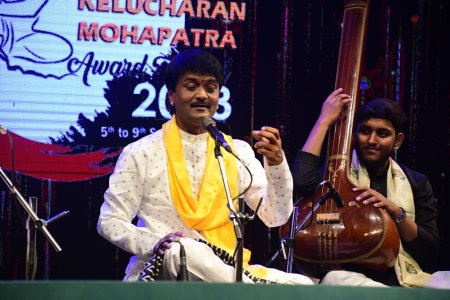 Jayateerth Mevundi The second artiste of the evening was Hindustani vocalist Jayateerth Mevundi. He struck an instant rapport with his presentation of the evening raag Durga. He pleased the audience with his phenomenal range of voice. If alaap created the ambience, his raag, taan and bistar took the audience on a journey where the beauty of music reigned supreme. The taans rendered were an epitome of perfection. Second piece in raag Kedar sung on the day of Janmashtami was so dear to aficionados. Needless to say, all the songs of the evening were on Krishna. The last song was in Bhairavi. A follower of Rashkhan - a sufi saint who became a Krishna bhakt - he sang his way into the hearts of music lovers. The treble and bass quality of his voice along with his presentation of gamakas endeared rasikas. A torch-bearer of the Kirana Gharana he is versatile in the Hindustani classical Santavani and Dasavani streams. His tonal excellence and electrifying style of singing was praiseworthy. He was accompanied on the tabla by V.Narahari and on the harmonium by Anushula More. 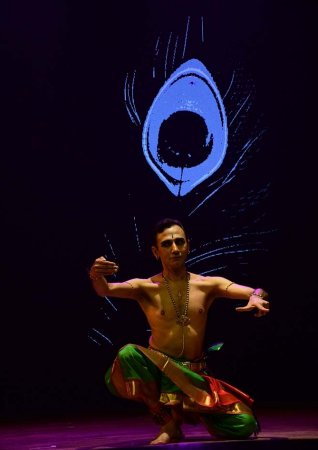 Praveen Kumar Day three featured P Praveen Kumar, Bharatanatyam teacher and a dancer par excellence. A disciple of Guru Narmada and Prof CV Chandrashekar, his angashuddhi is remarkable, he is well versed with the grammar of Bharatanatyam, and is a committed dancer known for his dedication. He commenced his recital with Muruga Kautvam in ragam Shanmughapriya, a traditional composition extoling the greatness of Lord Karthikeya. A dispeller of darkness, his alert and keen observations through his sharp eyes on his devotees ensures their safety. Flute music prepared the ambience suitable for the appreciation of an aesthetic presentation. As is wont, Ganesh Stuti was sung for a flawless recital. Soon after, Kartikeya, son of Shiva, came to the stage riding the peacock. Perfect korvais and araimandi position were maintained throughout. The next piece was a varnam, a composition of Thuraiyur Rajagopala Sharma, in Atana ragam set to adi talam exploring the tales and triumphs of Krishna. Praveen visualized him as a little child, who played pranks and he in turn also played pranks with him. However in the end when he showed his Vishwaroopa, he was beside himself with awe, but to the choreographer he remained the same little Krishna no matter what avatar of Vishnu he is. Praveen Kumar brought in a refreshing element of novelty by portraying the entire presentation as though he were speaking to little Krishna. His covering of the stage with neat Bharatanatyam strides was remarkable, so was the way when with a slight jump he sat down cross-legged. The studied stillness when he froze momentarily was eloquent. At that point he resembled a piece of sculpture that adorns temple walls. Ecstasy of flute music and bird song felt by the devotees of Krishna were the subtler nuances Praveen's abhinaya displayed and this transported one to a world where beauty reigned. The last piece was a padam, a rare composition which is centred around a Virahotkanthita Nayaka, who is repentant for deserting his family for another woman, who subsequently leaves him for another man. He has incurred god's ire and repents for his sins. The hero heads to Kashi to atone for his acts and realises the consequences of his karma. His ascetic like demeanour was emoted with subtlety. This was in ragam Mukhari and mishra chapu talam. He mesmerised the audience with his neat presentation, reliving his learnt form and re-choreographing them according to modern ethos. Musicians who accompanied him were K Navyashree on nattuvangam, Raghuram on vocal, Vinay Nagarajan on mridangam, and Mahesh Swamy on flute. 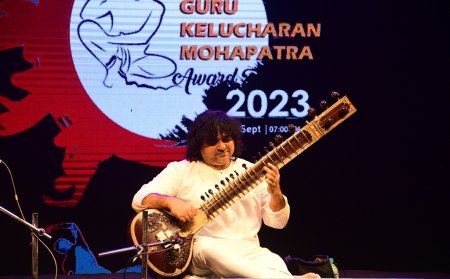 Niladri Kumar The second half of the evening was a sitar recital by the versatile Niladri Kumar. The jhala of the alaap created ripples of musical passages much to the delight of rasikas. The audience floated in the vibrations produced by the music. He opened his solo concert with Tilak Nat which was paired with Tilak Kamod, which ended with a rich jhala. He traversed with ease from 11 matra to 7 matra and finally to 16 matra beat. His mainstay was raag Tilak Kamod. The second piece was in raag Bhairavi. Though it has the epithet of being the queen among the morning ragas, it was a great hit with the audience. He received a standing ovation. 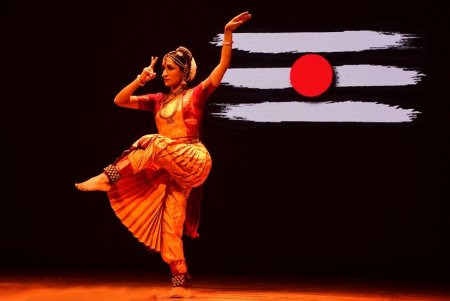 Amrita Lahiri Amrita Lahiri opened Day 4 of the GKCM award festival with her Kuchipudi recital with Ananda Nartana Ganapatim in ragam Nati, choreographed by her Guru Jaikishore Mosalikanti. The god who dances blissfully, one who is worshipped by sages, living in the heart of Shiva was meditated upon through dance. Usha Parinayam penned by Vedam Venkataraya Sastry was based on a mythology from the Bhagavata Purana. The wedding of Princess Usha, daughter of Banasura, to Aniruddha is an unusual love story choreographed by Swapnasundari. Usha fell in love with a young man whom she had met only in her dream. As if that was not strange enough, her friend Chitralekha sketched the picture of the person as Usha had described him to her. More strange is the fact that the picture drawn was that of Aniruddha, the grandson of Krishna. Amrita who had taken to Kuchipudi - with its roots in Yakshagana - early in life danced with quick foot movements making a spirited narrative with a great deal of dramatization and expressive eye movements, mesmerizing the audience. "Shiva Shiva bhava bhava" was the last piece. The Shiva Tarangam executed with locked feet on a brass plate at the end and moving the plate rhythmically with great dexterity was performed with Úlan. It was done after showing the descent of Ganga on Shiva's locks at the behest of King Bhagiratha whose intense and pious meditation to Shiva had earned him a boon, which the Lord of the mountains agreed to bestow upon him to prevent the world from drowning with the waters of the Ganga. The execution by Amrita was dramatic, striking the imagination of the gathered lovers of dance. The pleasing music featuring Sujesh Menon as the vocalist, Satish Krishnamurthy on mridangam, nattuvangam by S Vijay Kumar and violin by Mangala Vaidyanathan was savored with great delight. 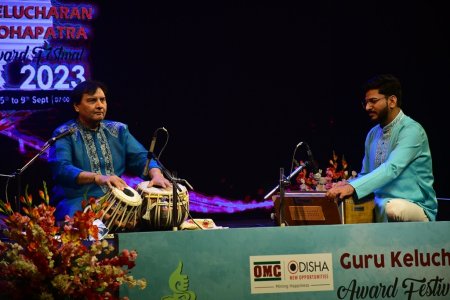 Ustad Akram Khan Solo tabalia Ustad Akram Khan is a seventh generation torch bearer of the Ajrada Gharana of tabla. He has retained more than 15 Kayadas conceptualised by his gharana. At first he acquainted the audience with the different sounds a tabla can produce and that tabla has its own language. He mixed the higher notes and the lower notes to create his own phrases. From the time he beat his first stroke on the instrument, he displayed his mastery over improvisations and ornamentations. Starting with Peshkar which through slow movements created slow phrases, he embarked on Kayadas - using two fingers according to the custom of his gharana - which had more speed than Peshkar, taking up 'Rela', which has more speed than Kayada soon after, building myriads of different and difficult phrases. Apart from bols and tukras, he regaled the audience with a number of Chakradhars and sure enough he drew claps from the audience. Rich and ornamented Chakradhars which are 3 times more than tihais flowed one after the other. At the end of a complex and lengthy tihai the concert came to an end. In short, all through his performance he succeeded in getting total attention from the audience, winning a standing ovation. The very talented Nilay Salvi played the harmonium. 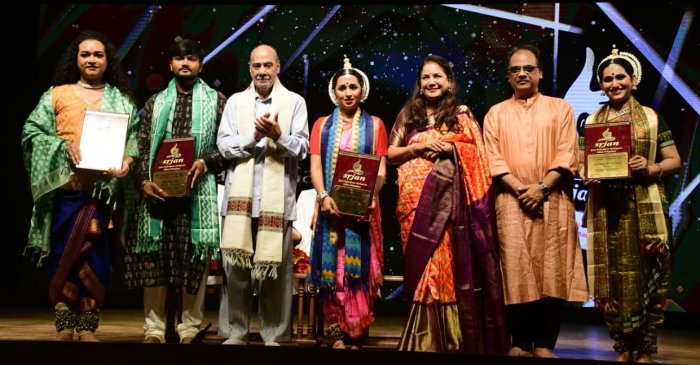 The Yuva awardees with Anant Mahapatra and Ratikant Mohapatra The final day featured the coveted award presentation ceremony and concluded with a cultural programme. Veteran theatre artiste Anant Mahapatra was awarded the prestigious Guru Kelucharan Mohapatra Award 2023. Guru Ratikant Mohapatra, Director, Srjan and Dean, Faculty of Arts, Communication and Indic Studies (FACIS), SSU gave his valedictory speech. GKCM Yuva Prativa Samman 2023 - which focuses on reviving the all important role of the solo artiste in classical music and dance - was awarded to Arupa Gayatri Panda, Siddhi Waikar (both Odissi dancers and disciples of Guru Aruna Mohanty and Guru Daksha Mashruwala respectively), Kathak dancer Vishal Krishna and Arup Das for Odissi music (mardala). The awardees regaled the audience with their presentations. Mardala player Arup Das, who explored the intricacies of the Odissi tala system with a laudable rendition, was ably accompanied on the harmonium by Muralidhar Swain. Siddhi Waikar presented Navagraha, the embodiment of infinite cosmic energy which turns the wheel of life, the wheel of karma or action. She offered her salutations to the nine planets - Surya, Som, Mangal, Buddh, Guru, Shukra, Shani, Rahu and Ketu. Choreographed by Guru Daksha Mashruwala, Navagraha is set to the music composition of Jateen Sahu with the rhythmic inputs of Rohan Dahale. 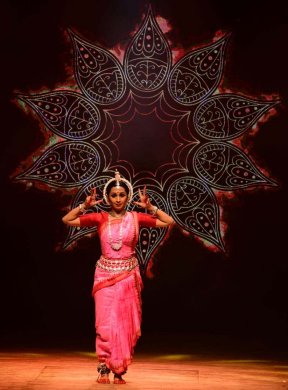 Siddhi Waikar 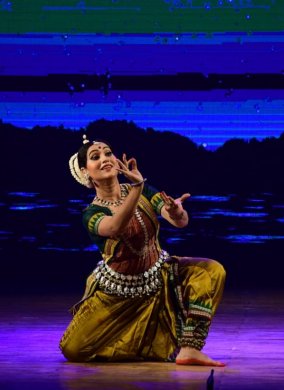 Arupa Gayatri Panda 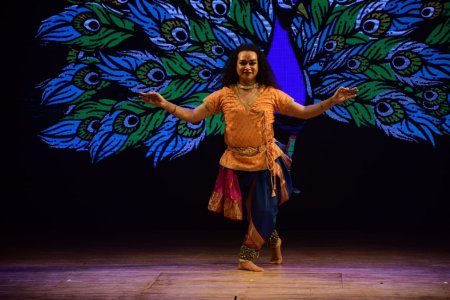 Vishal Krishna 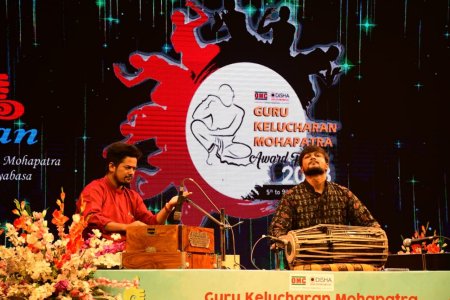 Arup Das Vishal Krishna performed the Shiva Kavitt Paran written by his great grandfather Acharya Pt. Sukhdev Maharaj followed by some technical compositions in Banaras Gharana in teen taal, 16 beats. He concluded with a bhajan choreographed by Madhavi Mudgal depicting the eternal love between Radha and Krishna. The final performance of the evening was by Arupa Gayatri Panda, who presented the ashtapadi Ramate Yamuna pulina vane, a composition from Jayadeva's Geeta Govinda. Choreographed by Guru Aruna Mohanty, Arupa's rendition was set to the music composition of Dr. Subas Pani and the rhythm composition of Guru Bijaya Barik, and was a befitting conclusion to the evening. The entire festival was curated, conceptualized, and designed by Guru Ratikant Mohapatra. Debiprasad Mishra cast a spell on the audience with his magical lighting. The elegant and striking visual media, both live and in the background, were by Dhilip Kumar. Compere Mrityunjaya Rath ably conducted the proceedings connecting the audience to what was being performed. 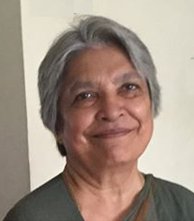 Tapati Chowdhurie trained under Guru Gopinath in Madras and was briefly with International Centre for Kathakali in New Delhi. Presently, she is a freelance writer on the performing arts. |